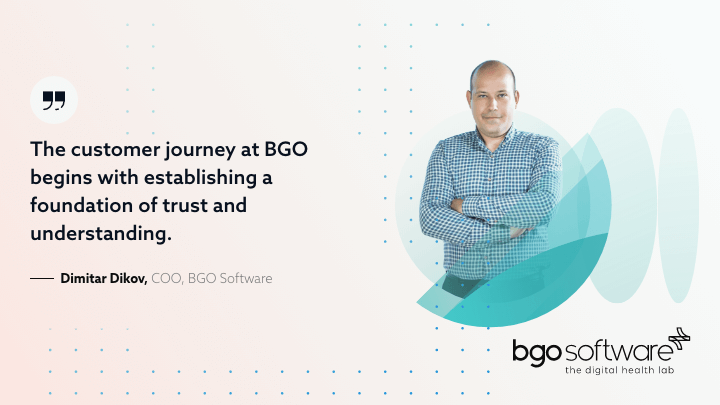When planning on investing in a new project for your business it is important to consider all the available models for efficient project management. Because of that, in this article, Dimitar Dikov, Chief Operation Officer at BGO Software, reviews all the options available to your business needs.
This article dives into the world of project management methodologies, tailor-made for everyone from up-and-coming startups to big-time pharmaceutical companies. It examines smart tactics like agile and waterfall, showing how they align with client goals, navigate risks, and keep budgets in check.
Dimitar highlights BGO’s client-centric approach, which not only understands but also clarifies clients’ visions for their projects. He takes us through a usual customer journey, starting with their first request all the way to crossing the finish line on a healthcare IT project.
Approaching new clients
According to our expert, effective project management is extremely important as the relationship between technology and patient care continues to evolve.
For many companies, the initial approach to new clients is not just about establishing a business relationship; it’s about diving deep into understanding the unique goals and challenges each client brings to the table.
In this next section, he delves into the nuances of how BGO approaches new clients and helps them understand their goals better to develop a vision for their business.
Understanding client goals and risks
The key to any successful project management strategy in healthcare lies in understanding what the client wants. Whether a small start-up or a large pharmaceutical corporation, each client enters with a set of financial and operational goals. To deal with this task, BGO places significant emphasis on helping the client identify these goals, as they guide the whole process of crafting the future IT solution.
The next crucial step is risk assessment. Different business sizes come with varying degrees of risk. For instance, a smaller company might be more vulnerable to budget fluctuations. Larger companies, on the other hand, might face complexities in aligning various departmental objectives. A successful approach involves evaluating the potential risks each project might encounter by factoring in the size and scale of the business.
BGO aims to determine how the risks associated with the project can be effectively mitigated. This involves a thorough analysis of potential pitfalls, financial implications, and operational obstacles that might arise during the project lifecycle. By proactively identifying these risks, the digital health leader can tailor its project management approach to protect the client’s interests and ensure a smoother execution path.
Budgeting and vision
Budgeting in healthcare IT projects is not just about allocating funds but the client’s vision and business plan.
Clients typically come with a clear idea of the return value they expect at the end of their interaction with BGO. This result usually is envisioned in the form of financial gain, acquiring new clients, or other subjective benefits aligned with their business goals.
“The biggest challenge arises when clients possess a clear end goal but lack a comprehensive plan to achieve it.”
In such scenarios, clients often strictly define their budgets based on their understanding of where they want to take their business. However, without a detailed roadmap, determining the time and cost required to reach these objectives becomes more difficult.
Project management methodologies
BGO Software utilizes various methodologies, each with its strengths and limitations, to cater to the diverse needs and objectives of its clients. This section explores two main methodologies: the agile approach and the waterfall method.
Dimitar highlights their unique characteristics and suitability for different project scenarios.
Agile approach
The agile approach is the more flexible of the two. This makes it the ideal choice for projects where timelines and costs are uncertain or subject to change. This approach is particularly beneficial in scenarios where the client’s vision is evolving or the project’s end goals are not entirely defined at the beginning.
At the core of the agile methodology is the principle of iterative development. Instead of a linear progression, the project is divided into smaller segments or ‘sprints’. This division allows for regular reassessment and adjustments as needed. This flexibility facilitates a more responsive approach to changing client requirements or unforeseen challenges.
However, the agile approach also has some limitations.
“The flexible nature of the agile approach can sometimes lead to the project’s objectives and deliverables continually expanding beyond the original plan, impacting timelines and budgets.”
The agile approach allows companies to build the skeleton of the IT solution and enhance it with additional functionalities over time. This helps experts like Dimitar to adapt to the client’s needs while keeping the project on track.
Waterfall method
In contrast to the agile approach, the waterfall method is characterized by being substantially more structured and as a result – less flexible.
“The waterfall method is best suited for projects with well-defined objectives, timelines, and budgets.”
The waterfall method follows a linear and orderly progression, where each phase of the project must be completed before moving on to the next. This structured approach allows for clear milestones and deadlines and makes it easier to manage budget constraints.
Since the project’s scope and deliverables are defined upfront, it provides clients with a clear picture of the costs involved. This makes this approach more budget-friendly and helps reduce the likelihood of unexpected expenses. However, this method offers limited flexibility to accommodate changes once the project is underway.
For clients who have a precise goal and a well-charted path to achieve it, Dimitar recommends the waterfall method. While it may not offer the same level of flexibility as the agile approach, its structured nature provides a sense of predictability and control, which benefits clients who prioritize budget adherence over adaptability.
Method selection for different company sizes
The process of selecting the right project management methodology is not one-size-fits-all.
According to Dimitar , it requires a deep understanding of various factors, including the size of the company and the broader economic environment. BGO Software, with its extensive experience in healthcare IT, has developed a nuanced approach to method selection.
Economic factors in decision-making
Global economic conditions play a pivotal role in shaping the decision-making process for project management methodologies.
“Economic stability or volatility can significantly influence a company’s risk tolerance, budget allocation, and overall strategy for IT projects.”
In times of economic uncertainty, companies may lean towards more predictable and budget-controlled methodologies, while a stable economy might encourage more flexible and experimental approaches.
BGO’s approach to method selection is sensitive to these economic factors. Our experts take into account the fact that economic conditions can directly impact a client’s capacity to absorb risks and adapt to changing project scopes. Therefore, assessing the current economic climate is a critical first step in advising clients on the most suitable project management strategy.
Preferences of small vs. large companies
According to our expert Dimitar, the size of a company also determines its preferred project management methodology.
Smaller businesses, particularly startups, often gravitate towards the waterfall method. This preference comes from the method’s structured nature, which provides a clearer picture of the budget and timelines. This is usually extremely important for companies with limited financial resources.
Startups typically require a high level of certainty in project costs and outcomes, as they often operate within tight budget constraints and have less room for financial maneuverability. In contrast, larger companies, including big pharmaceutical firms, tend to favor more flexible methodologies like agile.
Dimitar claims that larger companies often have projects where the idea is pitched at a senior management level without detailed planning. These companies can afford to incorporate detailed planning and documentation as part of the project execution process.
This preference for flexibility in larger companies can be attributed to their broader resource base and higher risk tolerance. They are more equipped to handle the uncertainties and dynamic changes that come with agile project management, allowing them to innovate and experiment with their projects.

Discover how we can help outsource Healthcare projects efficiently
Speak to an expert today, and see how our on-demand IT talent and augmented teams can efficiently deliver value at every step of your roadmap.

Comparison of waterfall and scrum methods
BGO Software employs both the waterfall and scrum methods depending on project needs. This section compares these two methodologies, highlighting their unique features and challenges.
Scrum framework within agile
Scrum is a subset of the agile methodology, which plays a critical role in BGO’s project management approach. It’s characterized by its decentralized nature, offering a more flexible and collaborative environment. Sprints are also fundamental to the scrum framework, allowing for rapid development and frequent reassessment of project goals and progress.
However, the scrum structure also imposes limitations during the execution process of a given IT solution. Once a sprint begins, its scope is generally locked in and restricts the developer’s ability to make changes until the next sprint. This aspect demands careful planning and prioritization of tasks before each sprint commences.
Waterfall method and risk management
In contrast to the dynamic nature of scrum, the waterfall method offers a more structured approach. A notable feature of this method, that is used by BGO, is the fixed-price period. This approach is important when it comes to mitigating financial risks for clients.
The scope, deadline, and budget are all defined for two months. The waterfall method provides clients with a clear understanding of what will be delivered and at what cost. This clarity is particularly beneficial for clients with strict budget constraints or those requiring a high level of certainty in project outcomes.
The customer journey at BGO Software
Navigating the customer journey effectively is a critical component of BGO’s project management framework.
This journey, from the initial engagement to the final stages of project initiation, is meticulously crafted to build trust, understand client needs, and ensure a smooth transition into the project execution phase.
Initial steps and building trust
Initial interactions are crucial as they set the tone for the entire project. The first step often involves an inquiry or a request from a potential client, followed by a series of introductory meetings.
BGO places great emphasis on understanding the client’s background, their business objectives, and the challenges they face. This phase is about listening and empathizing to create a comfortable environment for clients to share their concerns openly.
Discovery sessions and road mapping
Following the initial trust-building phase, BGO invites their clients to a couple of product discovery sessions. These sessions are integral to the customer journey, serving as a platform to delve deeper into the client’s specific needs and expectations.
During these sessions, BGO’s team collaborates closely with the client to explore various aspects of the proposed project. This includes understanding the technical requirements, the desired outcomes, and any objections the client may have. The objective is to gather as much relevant information as possible to inform the project planning process.
These discovery sessions are not just fact-finding missions; they are also about road mapping. Based on the insights gained, BGO outlines a potential path for the project, including key milestones, timelines, and deliverables. This roadmap serves as a preliminary plan, providing the client with a clear vision of how the project could end.
Contract signing and project initiation
The final phase in the customer journey is signing the contract and initiating the actual project. This stage marks the formal beginning of the partnership.
During this phase, the details agreed upon during the discovery sessions are formalized into a contract. This document outlines the scope of work, the project methodology, timelines, and financial agreements.
Once the contract is signed, BGO mobilizes its resources and network to start working on the project. Leveraging its extensive network and resource pool across the Balkans and the European Union, the digital health leader ensures that the right development team is assigned to the project.

Whether you’re a startup, a Fortune 100 company or a government organisation, our team can deliver a solution that works for you.
BGO Software
Conclusion
There is no set strategy that any company can follow to ensure success for their healthcare projects. However, a better understanding of the risks that each of the project management models offers is a great start to learning how to mitigate them.
Dimitar explains the benefits and limitations of the agile and waterfall approaches and compares them to give you a better idea of what to expect when choosing each one. The most important step is to develop your vision for what you want to achieve and then reach out to BGO Software to get expert advice on how exactly to approach each of the obstacles.

















